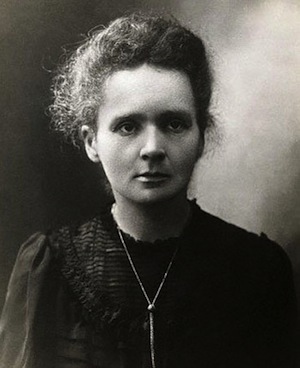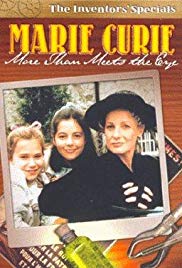MARIE CURIE: MORE THAN MEETS THE EYE
SUBJECTS — Biography; World/France & WWI; Medicine; Science-Technology;
SOCIAL-EMOTIONAL LEARNING — Female Role Model; Mother/Daughter;
MORAL-ETHICAL EMPHASIS — Responsibility.
AGE: 8 – 12; No MPAA Rating;
Drama; 1997; 54 minutes; Color.
MENU
DESCRIPTION
Marie Curie was the pre-eminent female scientist of her time. She was the first person to discover radioactivity and has received the Nobel Prize in physics. Her adopted city, Paris, is now threatened by the German invasion of WWI. Marie Curie knows that X-rays can look through human flesh and disclose the location of shrapnel. Some pioneering doctors are already saving lives with the new technique, but the tradition-bound French military is not. Nor are French army officers inclined to listen to a woman, even Madame Curie, on matters of military importance. This film describes Marie Curie’s heroic efforts to ensure that French soldiers did not die because of metal fragments hidden in their bodies.
“Marie Curie: More than Meets the Eye” also describes the efforts of two fictional young girls to stay with their mother in Paris despite the threat posed by the German army. The girls mistakenly believe that Madame Curie is a foreign spy. They try to expose her as proof that they should be allowed to stay in the city. The movie is one of the Inventors’ Specials, an award-winning series which introduces children to great scientists and inventors.
SELECTED AWARDS & CAST
Selected Awards: 1999 First Place “Gold Camera Award” from the U.S. International Film and Video Festival; 1998 KIDS FIRST! Endorsement from the Coalition for Quality Children’s Media; and Winner of a 1998 Parents’ Choice Recommendation.
Featured Actors: Kate Trotter, Natalie Vansie and Colene Rennison.
Director: Richard Mozer.
BENEFITS OF THE MOVIE
This film will introduce children to the greatest female scientist of the 20th century, the revolutionary benefits of X-ray technology, and the First World War.
POSSIBLE PROBLEMS
None.
PARENTING POINTS
Tell your child the information in the first paragraph of the Description of this movie. The resistance offered by the French military to adopt the new technique of X-ray imaging because it was suggested by a woman was very real. Point out the absurdity of sexism: that because Madame Curie was a woman, military officers would not listen to her despite the fact that she was a Nobel Prize winner, had discovered radioactivity, and knew how to save the lives of their soldiers using X-rays. After your child has seen this film and if he or she is 10 years of age, watch Madame Curie.
HELPFUL BACKGROUND

For more information about Marie Curie’s groundbreaking scientific discoveries, see Learning Guide to Madame Curie.
When WWI broke out, Marie Curie looked for a way to help her adopted country, France. She soon realized that new X-ray technology, just then being introduced, would be beneficial in locating shrapnel and bullets otherwise hidden in the bodies of wounded soldiers. At the time, the French Army had only one portable radiological unit. Marie Curie obtained an appointment as director of the Red Cross radiological service and, largely with donated funds, outfitted a van with X-ray equipment. When she tried to take her X-ray to the front, the French Army did not believe that it had much to learn from a woman about treating war wounds, even if that woman had won a Nobel Prize. The army relented only after the doctors at the front line hospitals saw how many lives the new technique could save. By the end of the war Marie Curie had established more than 200 permanent medical X-ray installations and brought 20 vans with portable X-ray units into service. She also trained the personnel to operate these installations. Thousands of allied soldiers survived severe battlefield wounds because of her efforts.
Marie Curie’s daughter, Irêne, was the first X-ray technician in this effort and was given a medal by the French Government for her work. Iréne Curie later became a research scientist. With her husband, she was awarded the Nobel Prize for chemistry in 1935 for the discovery of artificial radiation.
X-rays are beams of high energy photons with a wavelength of between .01 and .10 nanometers. X photons penetrate the body and are absorbed in different amounts depending on the density of the tissues through which they pass. For example, bones absorb more photons than do soft tissues; tumors often absorb more photons than do normal tissues. Foreign objects that might be in the body, such as bullets or shrapnel, also absorb X photons in a unique manner. When used for diagnosis, X-rays are beamed at the body and a photographic plate is inserted behind the body. The X-rays which are not absorbed are recorded on the photographic plate. The resulting picture shows the image of the different densities of tissues in the body. X-rays were discovered by Wilhelm Conrad Roentgen, a German professor of physics in 1895. One serious limitation of X-ray diagnosis is that since soft tissues absorb X-rays in a similar manner, they produce little or no contrast on the photographic plate. See Discussion Questions 4, 5 and 6.
There are many true incidents shown in this film. Marie Curie’s first responsibility when war broke out was to take her store of radium, the largest single amount of the element in the world, out of danger of being captured by the Germans. — Marie Curie’s fingers were burned by the radiation that she worked with for decades without proper protection. They hurt. — The old laboratory was empty because, just before the First World War broke out, Marie Curie opened the Radium Institute, the modern laboratory she had always dreamed of having. She was just moving into the new laboratory when the Germans invaded France. — The French Army initially resisted Marie Curie’s efforts to bring X-ray examining equipment to the front. She had to continually, convince, cajole, flatter and work around the army bureaucrats. — Paris was threatened by the Germans during the first part of the First War. The Germans succeeded in taking Paris and all of France, in the Second World War.
DISCUSSION QUESTIONS
1. See Discussion Questions for Use With any Film that is a Work of Fiction.
2. Why did the radium residue in the old laboratory glow in the dark?
3. Were the children right to want to stay in Paris despite the threat that the Germans would capture the city? Describe some of the things that could have happened to them if they had stayed in the city and it had fallen to the Germans.
4. How do X-rays work?
5. How do X-rays differ from visible light?
6. Why is it so important to remove shrapnel and bullets from wounds in the body? What often happens if they are not removed?
SOCIAL-EMOTIONAL LEARNING
1. Why did the French Army officer order Marie Curie and her portable X-ray machine away from the Front? Was he right to do this?
Female Role Model
2. What is it about Marie Curie that makes her a female role model?
3. Marie Curie had already made important scientific discoveries and won two Nobel Prizes. What was it about her that compelled her to make yet another major contribution, this time to medicine?
Mother/daughter
4. Did you have any questions about the quality of the relationship between Madame Curie and her daughter?
MORAL-ETHICAL EMPHASIS (CHARACTER COUNTS)
Discussion Questions Relating to Ethical Issues will facilitate the use of this film to teach ethical principles and critical viewing. Additional questions are set out below.
RESPONSIBILITY
(Do what you are supposed to do; Persevere: keep on trying!; Always do your best; Use self-control; Be self-disciplined; Think before you act — consider the consequences; Be accountable for your choices)
1. By the outbreak of World War I, Marie Curie’s position in the world of science was already secure. What Pillar of Character was she honoring when, against great odds and the resistance of French Army officers, she strove to bring X-ray technology to the battlefield?
ASSIGNMENTS, PROJECTS & ACTIVITIES
BRIDGES TO READING
BIBLIOGRAPHY
QUICK DISCUSSION QUESTION:
What are the similarities and differences between X-rays and light?
Suggested Response:
Both are streams of photons. However, X-rays have a higher energy level which also means a greater wave length than visible light. Our eyes are only sensitive to the wavelengths of visible light.
BUILDING VOCABULARY:
shrapnel, X-ray.
MOVIES ON RELATED TOPICS:
This film is one of the award-winning Inventors’ Specials. The other films in the series are Galileo: On the Shoulders of Giants; Einstein: Light to the Power of 2; Leonardo: A Dream of Flight; Newton: A Tale of Two Isaacs; and Edison: The Wizard of Light.
A fabulous film for ages 10 – adult about Marie Curie’s most important scientific work, the discovery that radioactive energy came from inside the atom, is Madame Curie.
Search Lesson Plans for Movies
Get our FREE Newsletter!
* we respect your privacy. no spam here!
Follow us on social media!
I am text block. Click edit button to change this text. Lorem ipsum dolor sit amet, consectetur adipiscing elit. Ut elit tellus, luctus nec ullamcorper mattis, pulvinar dapibus leo.




